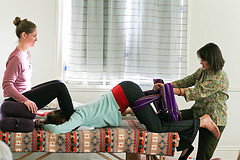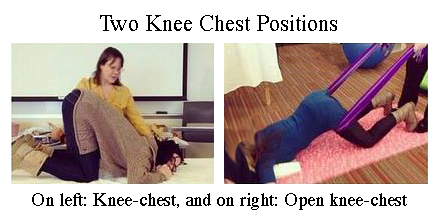
The Open-knee Chest:
Contractions can then rotate the baby in that extra space. Labor contractions keep the baby’s head down!
Does your baby seem stuck just inside the top of the pelvis (nurses would call this -2 station)? Would you like to help the labor start over again and go smoother? Then the Open-knee Chest (OKC) may be the technique for you. The OKC helps back the baby out of the pelvic brim so you can start over in a better position.

“Open” means there is a wider distance from your spine to your pubic bone. The spine and thigh make a “letter A.”
It is not strictly necessary to jiggle the mother’s hip, but it may help the baby back out more quickly.
Labor contractions help Open-knee Chest work. OKC allows the spaces between the contractions to let the baby back up about 1 centimeter and lets the contractions have a chance to rotate the baby to a better position. This is why the mother is in this position between and through the contractions.
Open-knee Chest is not about how wide open the knees are, but rather that the knees are far from the spine, opening the pelvic inlet.
Please note: There is a certain level of commitment to make this technique work. The birthing woman should know that this is effective, but requires her to be in this position for about 40 minutes (It may be effective in less time, but we can’t assume it will).
Open-knee Chest can be used in:
Some doulas and midwives suggest the Open-knee Chest for a stall in labor. This position may be especially useful for:
The indications may be:
Ask your care provider if there is any reason you wouldn’t want to be upside down in the inversion or Open-knee Chest position.
Don’t do Open-knee Chest if:
Is the baby engaged? If not, do engagement activities first, such as the Side-lying Release.
To potentially reduce the time it may take to reposition the baby, do the Shake the Apple Tree technique. The mother’s buttock are grasped and shaken mildly, in short “shivers” for a long time. Her muscles are relaxed from rapid, gentle jiggling.
Follow this challenging inversion with a nice, relaxing shower. Bend your knees and lean forward, resting your arms on the wall of the shower. Or, if you don’t want a shower, lean and rest your upper body on a dresser while your knees are slightly bent and you can sway your hips back and forth to relax your muscles.
Midwife Nicole Morales, CPM and Spinning Babies® Approved Trainer in San Diego, teaches us to Shake the Apple Tree during a Forward-leaning Inversion as a replacement for Open-knee Chest.
This article is to show you what OKC is, but it is not highly recommended. It’s handy occasionally, but balance your body before relying on gravity, in general, and sometimes you don’t have to do these more extreme positions.
For additional education to even further enhance your pregnancy and labor preparation, shop our extensive collection of digital downloads, videos, DVDs, workbooks, and more.
Activities for pregnancy comfort and easier birth.